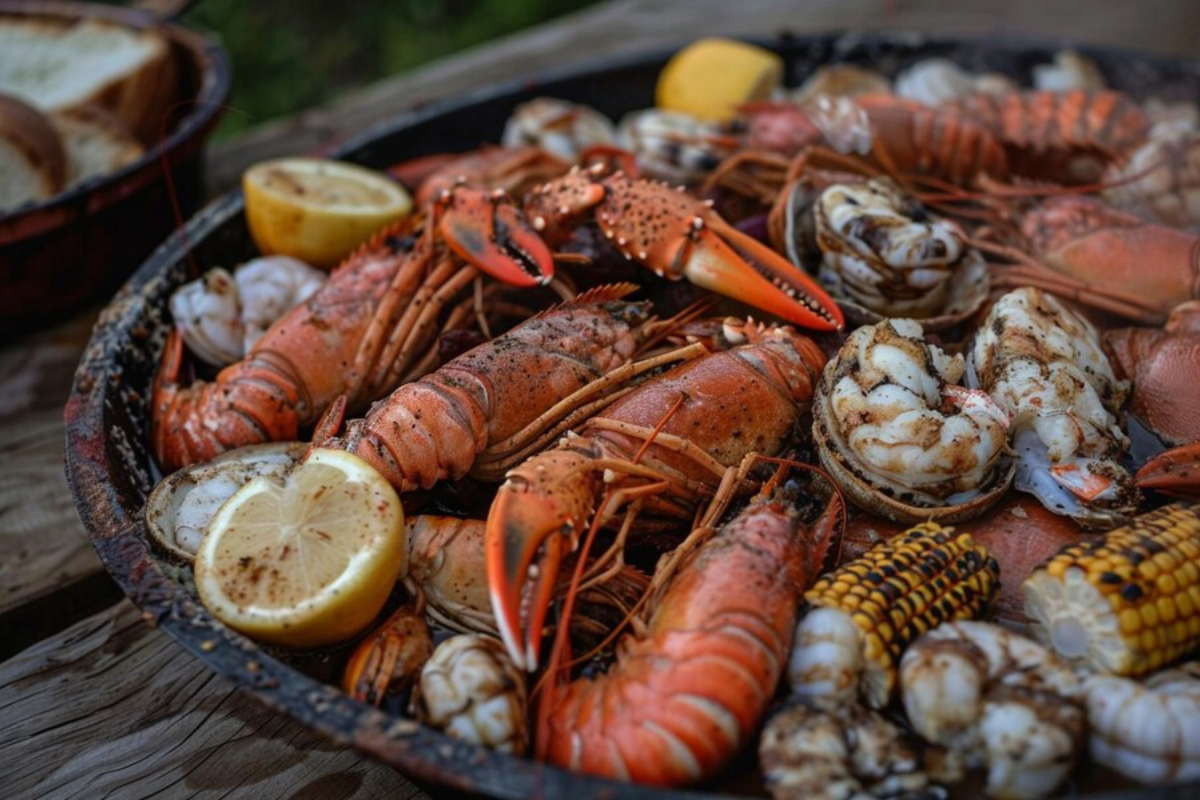Seafood boils are a cherished tradition in many parts of the world, particularly in the Southern United States, where gatherings around a large pot of boiling seafood and vegetables are a staple of social events. But as with any beloved culinary tradition, the question of health inevitably arises: Is seafood boil healthy? This article will delve deep into the nutritional aspects of a seafood boil, explore potential health concerns, and offer practical tips on how you can enjoy this flavorful dish in a healthier way.
What is a Seafood Boil?
A seafood boil is a cooking method where various types of seafood typically shrimp, crab, and crawfish are boiled together with starchy vegetables such as potatoes and corn. The dish is heavily seasoned with a mixture of spices, often Cajun or Creole, and sometimes includes additional ingredients like sausages, butter, and lemons.
This communal dish is more than just a meal; it’s a cultural experience that brings people together. The ritual of gathering around a large pot, the anticipation as the ingredients cook, and the shared enjoyment of the final product all contribute to the seafood boil’s enduring popularity.
But while seafood is generally recognized as a healthy food group, rich in protein and omega-3 fatty acids, the other components of a seafood boil , such as the high-sodium seasonings and fatty additions can turn this meal into a less-than-healthy option. Let’s take a closer look at the nutritional profile of a typical seafood boil.
Nutritional Overview of a Seafood Boil
Seafood is often celebrated for its nutritional benefits. It’s a low-calorie, high-protein food that’s packed with essential nutrients like omega-3 fatty acids, vitamin D, and selenium. These nutrients are associated with numerous health benefits, including improved heart health, brain function, and reduced inflammation.
Key Nutritional Benefits of Seafood:
- High Protein Content: Seafood is an excellent source of high-quality protein, which is essential for building and repairing tissues, producing enzymes and hormones, and maintaining muscle mass.
- Omega-3 Fatty Acids: These essential fats found in seafood like fish and shrimp are known to support heart health, reduce inflammation, and contribute to brain health.
- Vitamins and Minerals: Seafood is rich in various vitamins (such as B-complex vitamins) and minerals (such as selenium, iodine, and zinc) that are vital for overall health.
However, while seafood itself is nutrient-dense, the other ingredients and seasonings used in a traditional seafood boil can introduce elements that may not be as health-friendly.
Health Concerns in a Seafood Boil:
- High Sodium Content: The spices and seasonings used in a seafood boil, particularly in Cajun or Creole varieties, are often high in sodium. A single serving of seafood boil can contain over 1,000 milligrams of sodium, which is more than half of the recommended daily intake. Consuming high levels of sodium can lead to hypertension (high blood pressure) and increase the risk of heart disease.
- High Caloric Content: Starchy vegetables like potatoes and corn, along with butter and sausage, create a high-calorie meal. These ingredients add flavor and texture but significantly increase the calorie count, making it easy to overconsume and potentially leading to weight gain.
- Unhealthy Fats: The inclusion of processed meats like sausage and the use of butter add saturated fats to the dish. Saturated fats have been linked to an increased risk of cardiovascular disease when consumed in excess.
These factors can make a traditional seafood boil less healthy than it appears at first glance. But does that mean you should avoid seafood boils altogether ? Not necessarily. With some thoughtful modifications, you can enjoy this dish in a way that aligns with your health goals.
Making Your Seafood Boil Healthier
The good news is that there are several ways to enjoy a seafood boil without compromising your health. By making some strategic changes to the ingredients and cooking methods, you can transform this hearty dish into a more balanced meal.
1. Opt for Low-Sodium Seasonings
Traditional seafood boils often rely on pre-packaged seasoning mixes that are high in sodium. Instead of using these, consider making your own seasoning blend at home, where you can control the amount of salt. Use a variety of herbs and spices like garlic, onion powder, paprika, cayenne pepper, and lemon zest to add flavor without relying on salt.
Additionally, consider using fresh herbs like parsley, dill, and thyme, which can add both flavor and nutrients to your seafood boil. If you must use store-bought seasoning, look for low-sodium options and be mindful of the quantity you use.
2. Choose Healthier Protein Sources
While shrimp, crab, and crawfish are common choices for a seafood boil, consider incorporating a wider variety of seafood to increase the nutritional value of the dish. For example, adding salmon or cod can boost the omega-3 content and provide additional protein without adding extra fat.
If you enjoy adding sausage to your boil, opt for leaner varieties or even turkey sausage, which has less saturated fat than pork sausage. Alternatively, you can skip the sausage altogether and focus on the seafood, which is naturally lower in fat.
3. Incorporate More Vegetables
The vegetables in a seafood boil typically include potatoes and corn, both of which are starchy and can contribute to a higher calorie count. To add more nutrients and fiber to your meal, consider including non-starchy vegetables like broccoli, zucchini, asparagus, and bell peppers. These vegetables are low in calories but high in vitamins, minerals, and antioxidants, making them a great addition to any meal.
By increasing the proportion of vegetables in your boil, you can create a more balanced dish that is rich in nutrients while still being satisfying.
4. Use Healthier Fats
Butter is a traditional ingredient in many seafood boils, but it’s also high in saturated fat. Instead of butter, consider using olive oil or avocado oil, which are sources of healthy monounsaturated fats. These fats are beneficial for heart health and can help reduce bad cholesterol levels.
If you prefer butter’s flavor, use it sparingly. Consider a plant-based butter alternative with lower saturated fat. Fresh lemon juice or a splash of vinegar can also brighten your boil’s flavors without adding extra fat.
5. Consider Alternative Cooking Methods
While boiling is the traditional method for preparing a seafood boil, there are other cooking methods that can help reduce the calorie and fat content of the dish.
- Baking: Baking your seafood and vegetables with a drizzle of olive oil and herbs can be a healthier alternative to boiling. Baking helps retain the natural flavors and nutrients of the ingredients while reducing the need for added fats.
- Steaming: Steaming is another excellent cooking method that preserves the nutrients in seafood and vegetables. It’s a gentle cooking method that doesn’t require added fats, making it a great option for those looking to reduce their calorie intake.
6. Practice Portion Control
One of the easiest ways to enjoy a seafood boil in a healthier way is by practicing portion control. Given the communal nature of a seafood boil, it’s easy to overindulge. To avoid this, serve yourself a moderate portion and fill your plate with plenty of vegetables.
Eating mindfully and paying attention to hunger and fullness cues can help you enjoy the flavors of the dish without overeating. If you’re hosting a seafood boil, consider providing smaller serving bowls to encourage portion control among your guests as well.

The Health Benefits of Seafood Boils
Despite the potential downsides, a seafood boil can offer several healthy when prepared thoughtfully. When you focus on the seafood and vegetables, you’re consuming a meal that’s rich in nutrients and low in unhealthy fats.
1. Omega-3 Fatty Acids for Heart Health
Seafood like shrimp, crab, and fish are excellent sources of omega-3 fatty acids, which are essential for heart health. Omega-3s have been shown to reduce inflammation, lower blood pressure, decrease triglycerides, and reduce the risk of heart disease. Including a variety of seafood in your diet can help you meet your omega-3 needs and support overall cardiovascular health.
For more information on the benefits of omega-3s, visit this guide on omega-3 fatty acids.
2. High-Quality Protein for Muscle Maintenance
Seafood is a high-quality protein source essential for muscle maintenance, tissue repair, and a healthy metabolism. It is also lower in saturated fat than red meat, making it a healthier option for reducing unhealthy fat intake.
3. Rich in Vitamins and Minerals
The seafood and vegetables in a seafood boil are rich in various vitamins and minerals that are important for overall health. For example, shrimp is a good source of selenium, a powerful antioxidant that supports immune function and thyroid health. Potatoes provide potassium, which helps regulate blood pressure, and corn offers fiber and vitamin C, which support digestive health and immune function.
By adding various seafood and vegetables to your boil, you create a nutrient-dense meal with numerous health benefits.
Frequently Asked Questions About Seafood Boils
Is a seafood boil good for weight loss?
A seafood boil can fit into a weight loss plan with mindful ingredient choices and controlled portion sizes. Focus on lean seafood, non-starchy vegetables, and healthy fats, and practice portion control to avoid overconsuming calories.
What makes a seafood boil unhealthy?
High sodium, excessive butter, and processed meats like sausage are the main factors that make a seafood boil unhealthy. By making some simple substitutions, you can reduce the sodium, fat, and calorie content of the dish.
Can I eat a seafood boil if I have high blood pressure?
Yes, but it’s important to use low-sodium seasonings and control portions. Seafood boil is a healthy choice for those with high blood pressure. However, be mindful of the sodium in seasonings and avoid adding too much salt.
How can I reduce the sodium content in a seafood boil?
To reduce sodium, create your own seasoning blend at home. Use herbs and spices to add flavor instead of relying on salt. You can also use fresh lemon juice or vinegar to enhance the flavors of the dish.
Is it possible to enjoy a seafood boil on a low-fat diet?
Yes, you can enjoy a seafood boil on a low-fat diet by avoiding butter and processed meats. Choose to bake or steam your seafood. Use healthy fats like olive oil or avocado oil in moderation, and focus on lean seafood and vegetables.
Conclusion
A seafood boil can be healthy and enjoyable meal when prepared with health in mind. Choose low-sodium seasonings, lean proteins, and healthier cooking methods to enjoy this classic dish while staying healthy.
To improve your cooking skills and find more healthy recipes, check out this article on how to cook frozen broccoli in an air fryer. You’ll discover tips and techniques that fit a healthy diet.


1 thought on “Is seafood boil healthy ?”